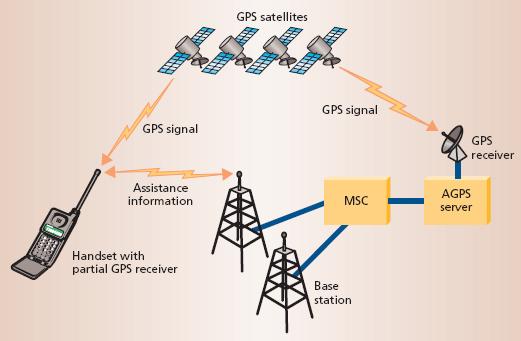Min Yin (Casey) Yap
Future Technology: Assisted GPS
GPS
Without much doubt, most of us, if not all, are aware of what is the GPS (Global Positioning System) technology. Though we know about the advantages of GPS, it suffers from three significant limitations:
• The mobile unit must locate and receive signals from at least four satellites to be able to determine its location. This process of locating satellites, receiving the data and achieving a position fix may take several minutes. This delay is problematic to real-time applications, such as the location-based services.
• The mobile unit needs a clear view of the sky to successfully receive signals from the satellites. Under unfriendly conditions, such as in building, in urban ‘canyons’, accuracy of the position fix can be compromised.
• Finally, there remain questions of cost, size and power consumption when incorporating GPS receivers into trendy, miniature handsets.
Introducing Assisted-GPS (A-GPS)
Figure 1: Assisted-GPS concept
A-GPS differs from regular GPS by adding another element, the AGPS Server. In regular GPS networks there are only GPS satellites and GPS receivers. As Figure 1 shows, AGPS consists of
• a wireless handset with a partial GPS receiver
• an AGPS server with a reference GPS receiver that can simultaneously “see” the same satellites as the handset
• a wireless network infrastructure consisting of base stations and a mobile switching center.
In A-GPS networks, the mobile handset has limited processing power and usually in a less ideal location for position fixing (eg: inside a building) communicates with the Assistance Server (A-GPS Server in Figure 1) that has high processing power. Since the mobile handset and the Assistance Server share the tasks, the process is quicker and more efficient than traditional GPS, albeit dependent on cellular coverage.
Advantages of A-GPS
• Shorter Delay
The network can accurately predict the GPS signal the handset will receive and convey that information to the mobile, greatly reducing search space size and shortening the TTFF (Time to First Fix) from minutes to a second or less.
• Higher Accuracy
A-GPS is accurate within 50 meters when users are indoors and 15 meters when they are outdoors, well within federal guidelines and an order of magnitude more sensitive than conventional GPS.
• Less-Complexity of Mobile Unit
Because the network performs the location calculations, the handset only needs to contain a scaled-down GPS receiver. The low complexity has also minimal impact on the battery life of mobile unit.
References
1. Assisted GPS: A low infrastructure approach
